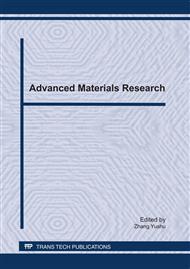[1]
A. Trovarelli, Catalysis Reviews - Science and Engineering, Vol. 38 (1996), p.439.
Google Scholar
[2]
X. Wang, J. A. Rodriguez, J. C. Hanson, D. Gamarra, A. Martinez-Arias, M. Fernandez-Garcia, J. Phys. Chem. B, Vol. 110 (2006), p.428.
Google Scholar
[3]
T. Zhu, L. Kundakovic, A. Dreher, M. Flytzani-Stephanopoulos, Catal. Today, Vol. 50 (1999), p.381.
Google Scholar
[4]
S. Park, J. M. Vohs, R. J. Gorte, Nature, Vol. 404 (2000), p.265.
Google Scholar
[5]
Z. Yang, B. He, Z. Lu, K. Hermansson, The Journal of Physical Chemistry C, Vol. 114 (2010), p.4486.
Google Scholar
[6]
M. M. Branda, N. C. Hernandez, J. F. Sanz, F. Illas, J. Phys. Chem. C, Vol. 114 (2010), p. (1934).
Google Scholar
[7]
W. Shan, M. Luo, P. Ying, W. Shen, C. Li, Applied Catalysis A: General, Vol. 246 (2003), p.1.
Google Scholar
[8]
J. B. Wang, Y. -L. Tai, W. -P. Dow, T. -J. Huang, Applied Catalysis A: General, Vol. 218 (2001), p.69.
Google Scholar
[9]
Z. Chafi, N. Keghouche, C. Minot, Surface Science, Vol. 601 (2007), p.2323.
Google Scholar
[10]
G. Kresse, J. Furthmuller, Phys. Rev. B, Vol. 54 (1996), p.11169.
Google Scholar
[11]
P. E. Blöchl, Phys. Rev. B, Vol. 50 (1994), p.17953.
Google Scholar
[12]
J. P. Perdew, J. A. Chevary, S. H. Vosko, K. A. Jackson, M. R. Pederson, D. J. Singh, C. Fiolhais, Phys. Rev. B, Vol. 46 (1992), p.6671.
DOI: 10.1103/physrevb.46.6671
Google Scholar
[13]
S. L. Dudarev, G. A. Botton, S. Y. Savrasov, C. J. Humphreys, A. P. Sutton, Phys. Rev. B, Vol. 57 (1998), p.1505.
Google Scholar
[14]
M. Nolan, S. C. Parker, G. W. Watson, Surf. Sci., Vol. 595 (2005), p.223.
Google Scholar
[15]
A. Rohrbach, J. Hafner, G. Kresse, Physical Review B, Vol. 69 (2004), p.075413.
Google Scholar
[16]
G. Henkelman, A. Arnaldsson, H. Jonsson, Comput. Mater. Sci., Vol. 36 (2006), p.254.
Google Scholar
[17]
Z. Yang, Z. Lu, G. Luo, Phys. Rev. B, Vol. 76 (2007), p.075421.
Google Scholar
[18]
J. A. Rodriguez, T. Jirsak, L. Gonzalez, J. Evans, M. Perez, A. Maiti, J. Chem. Phys, Vol. 115 (2001), p.10914.
Google Scholar
[19]
Z. -P. Liu, S. J. Jenkins, D. A. King, Physical Review Letters, Vol. 94 (2005), p.196102.
Google Scholar


